Menu
-
MenuVissza
- Home
-
Kategóriák
-
-
Kategóriák
-
Zöldségmagok
-
Fajták országonként
- Fajták Örményország
- Fajták BiH
- Fajták Horvátországból
- Fajták Franciaországból
- Varieties from Germany
- Varieties from Greece
- Varieties from Hungary
- Fajták India
- Varieties from Italy
- Fajták Japánból
- Fajták Észak-Macedónia
- Varieties from Peru
- Varieties from Russia
- Varieties from Serbia
- Szlovéniából származó fajták
- Varieties from Spain
- Varieties from Thailand
- Fajták Törökország
- Varieties from USA
- Paradicsommag
- Kukoricamag
- Tök család magjai
- Babcsalád
- Uborka mag
- Paprikamag
- Sárgarépa család
- Hagyma család
- Saláta magok
- Burgonya család
- Káposzta család
- Retekmag
- Cékla család
- Görögdinnye magok
- Dinnye magok
- Karfiolmag
- Napraforgó család
-
Fajták országonként
- Gyümölcsmag
- Chili paprika magok
- Gyógynövénymagok
- Hegymászó növények magjai
- Fák - cserje - magok
- Pálma mag
- Díszes fűmagok
- Dohánymagok
-
Zöldségmagok
-
-
-
-
- ÚJ TERMÉKEK
- Fiók létrehozása
- Szállítás - fizetés
- FAQ
- Kezdőlap
-
- Zöldségmagok
- Fajták országonként
- Fajták Észak-Macedónia
- Fajták Horvátországból
- Fajták Törökország
- Fajták BiH
- Fajták Japánból
- Fajták India
- Fajták Örményország
- Fajták Franciaországból
- Szlovéniából származó fajták
- Varieties from Serbia
- Varieties from Greece
- Varieties from Russia
- Varieties from Italy
- Varieties from Spain
- Varieties from USA
- Varieties from Germany
- Varieties from Peru
- Varieties from Thailand
- Varieties from Hungary
- Karfiolmag
- Dinnye magok
- Görögdinnye magok
- Napraforgó család
- Cékla család
- Retekmag
- Paradicsommag
- Kukoricamag
- Tök család magjai
- Babcsalád
- Uborka mag
- Paprikamag
- Káposzta család
- Burgonya család
- Hagyma család
- Saláta magok
- Sárgarépa család
- Fajták országonként
- Csomagolás és ilyesmi
- Gomba micélium
- Növényi gumókat
- Organikus fűszerek
- Ayurveda növények
- F1 hibrid magvak
- Banánmag
- Nincs PayPal és kártyás fizetés X
- Óriás növények magjai
- Hidegen ellenálló növények
- Bambuszmag
- Gyümölcs- és zöldségformák
- Nagy csomag magok
- Gyümölcsmag
- Chili paprika magok
- Gyógynövénymagok
- Hegymászó növények magjai
- Fák - cserje - magok
- Pálma mag
- Díszes fűmagok
- Dohánymagok
- Szállítás - fizetés
- Vetési utasítások
- Növények gondozása
- Vízinövények magjai
- Kaktuszmag
- Virágmag
- Zöldségmagok
Last Product Reviews
These peppers came all the way from eastern Europe and took a while at no f...
By
 Fitim Berani on 21/09/2023
Fitim Berani on 21/09/2023
Verified Purchase
Last customers
- Tanja, Beograd, Serbia
- Pete, Cleves, United States
- Stef, Waalwijk, Netherlands
- Sonia, Minervino di Lecce, Italy
- Adrian, Ingolstadt, Germany
- CORINNE, NOTRE DAME DE LONDRES, France
- Dušan, KRAVANY NAD DUNAJOM, Slovakia
- Arno, Ehrenkirchen, Germany
- Costas, LARNACA , Cyprus
- Fulvio francesco, Santa Domenica Talao, Italy
- william, Dun, France
- Aymeric , Saint tricat, France
- Ricard, Sant Celoni, Spain
- Maureen , Enniscorthy Co Wexford , Ireland
- Paul, St. Vigil in Enneberg (BZ), Italy
- Ricardo jorge , Viseu , Portugal
- Radosav, Kragujevac, Serbia
- Sylvie, Neyruz, Switzerland
- Julien, Scionzier, France
- Zoran, Vinca, Serbia
- Josef, Hochdorf-Assenheim, Germany
- Davide, London, United Kingdom
- Kimberly, Victoria, Gozo, Malta
- Saša , Beograd, Serbia
- Ewa, Galway, Ireland
- Ioannis , Kato Achaia, Greece
- Samuele, Milano, Italy
- Dubravka, Niš , Serbia
- Theodoros, Grevena, Greece
- goderis, bredene, Belgium
1756 termék található.
1705-1716 / 1756 elem mutatása
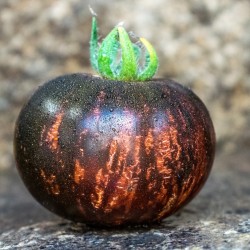
Queen Of The Night...
Ár
1,85 €
SKU: VT 123
Seeds Gallery Com,
5/
5
<h2><strong>Queen Of The Night paradicsommag</strong></h2>
<h2><span style="color: #f80000;"><strong>Ár egy csomag 10 magot.</strong></span></h2>
A Königin der Nacht - A Queen Of The Night egy friss kék fajta a Rajnából, Németországból. Annyit biztosan tudunk, hogy ez az új fajta Németországból származik a Rajna környékéről, és további információk nem ismertek.<br><br>A kerek vörös-narancssárga csíkos gyümölcsök nagyon erős kék-fekete hatással vannak a felső felére az antocianin miatt. Minél inkább a napfénynek vannak kitéve a gyümölcsök, annál erősebb ez az antioxidáns (ugyanaz, mint az áfonya), annál inkább a gyümölcsök kékre/feketére válnak.<br><br>Sűrű húsú, de nagyon lédús, erős paradicsom ízű.<br><br>Közepes méretű, meghatározatlan, körülbelül 1,5 m -1,75 m -es növekvő növények, magas hozammal, ésszerűen a szezon elején, mégis kék fajta.<script src="//cdn.public.n1ed.com/G3OMDFLT/widgets.js"></script>
VT 123 (10 S)


Variety from America
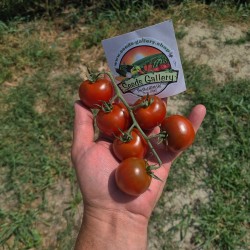
Campari paradicsommag
Ár
1,85 €
SKU: VT 124
Seeds Gallery Com,
5/
5
<div>
<h2 class=""><strong>Campari paradicsommag</strong></h2>
</div>
<div>
<h2><span style="color: #ff0000;"><strong>Ár egy csomag 10 magot.</strong></span></h2>
</div>
<div></div>
<div>A Campari egy paradicsomfajta, amely lédúsága, magas cukorszintje, alacsony savassága és a liszt hiánya miatt ismert. A Camparis mély fekete-vörös és nagyobb, mint a cseresznyeparadicsom, de kisebb és kerekebb, mint a szilvaparadicsom. A szupermarketekben gyakran "paradicsom-a-szőlőként" (TOV) értékesítik őket, amely paradicsomkategória az évek során egyre népszerűbbé vált. A Campari paradicsomot különböző, hasonló tulajdonságokkal rendelkező fajtákból lehet előállítani, a szabvány a Mountain Magic. Hibridként a magvak 150 ezer dollárba kerülnek fontonként.</div>
<div></div>
<div>A Mastronardi Produce cég 2003 -ban regisztrálta a "Campari" kifejezést az Egyesült Államok védjegyeként paradicsoma számára; a védjegyet azonban 2006 -ban megtámadták azon állítások alapján, hogy a "Campari" valójában a holland Enza Zaden cég által az 1990 -es években tenyésztett paradicsomfajta általános neve.</div>
<div></div>
<div>Jellemzők</div>
<div>Egy tipikus Campari fajta gömb alakú, szabályos levelekkel, és ellenáll a dohánymozaik-vírusnak. A növény 1,8–2,4 m magasra nő, és 70–80 nap alatt érik. </div>
<div></div>
<script src="//cdn.public.n1ed.com/G3OMDFLT/widgets.js"></script>
VT 124 (10 S)

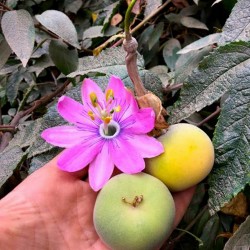
Tauso magvak (Passiflora...
Ár
3,50 €
SKU: V 120
Seeds Gallery Com,
5/
5
<h2 class=""><strong>Tauso magvak (Passiflora coactilis)</strong></h2>
<h2><span style="color: #ff0a0a;"><strong>A csomag ára 3 magot tartalmaz.</strong></span></h2>
Erőteljes, örökzöld hegymászó, háromlábú levelekkel és rózsaszín virágokkal, majd kerek, sárgás gyümölcsökkel, amelyek ehetők és aromásak. A Passiflora coactilis egy növény, amely hűvös, magasan fekvő felhőerdőkből származik az Andokban Dél -Amerikában, Kolumbia délnyugati részén és Ecuadorban 2200 és 3600 m között. jól alkalmazkodik a hűvös körülményekhez, és sok meleg mérsékelt éghajlaton nő az USDA 9 -es és annál magasabb zónáiban.<br><br>Fagyos időben a levelek és hajtások megsérülhetnek, de tavasszal újból kinőnek az alapból.
<script src="//cdn.public.n1ed.com/G3OMDFLT/widgets.js"></script>
V 120 (3 S)

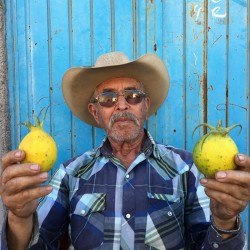
Jarilla magvak (Jarilla...
Ár
7,95 €
SKU: V 72
Seeds Gallery Com,
5/
5
<h2 class=""><strong>Jarilla magvak (Jarilla caudata)</strong></h2>
<h2><span style="color: #ff0a0a;"><strong>Ár egy csomag 3 magot.</strong></span></h2>
A Jarilla caudata meglehetősen látványos növény és papaya rokon, meglehetősen rendkívüli és rendkívül szokatlan gyümölcsökkel. Függőleges vagy kúszó, száraz lombhullató, lágyszárú évelő, Mexikóban és Közép -Amerikában őshonos, ahol xerofita cserjésekben és lombhullató erdőkben nő, 1500 és 2000 m közötti magasságban.<br><br>A Jarilla heterophylla-hoz hasonlóan zamatos gumót termel, amely zöld vagy lilás-zöld szárakat tartja, amelyek az aljától ovális, lándzsa alakú levelekkel és fehéres virágokkal, esetenként lila csíkokkal ágaznak el. A virágokat hosszúkás, ellipszis alakú gyümölcsök követik, amelyek akár 30 cm hosszúak is lehetnek, hosszú, szarvszerű nyúlványokkal. A zöld világosabb és sötétebb árnyalataiban foltosak, és éretten sárgulnak, míg a "szarvak" lilás színűek.<br><br>A gyümölcsök ehetők, és alkalmanként megtalálhatók a helyi piacokon. A lágy gyümölcsöket nyersen fogyasztják, míg a teljesen érett gyümölcsöket frissítő ital készítésére használják. Egy régi mexikói recept szerint a Jarilla caudata gyümölcsökből konzerveket is lehet készíteni, és különösen finomak, ha kókuszdióval kombinálják.<br><br>A papaja ezen rokona a legtöbb meleg mérsékelt éghajlaton eléri a legkevesebb USDA 9. zónát, és még bizonyos szárazságot és hideget is túlél. Érdekes faj lenne más papaya rokonokkal való hibridizációhoz.
<script src="//cdn.public.n1ed.com/G3OMDFLT/widgets.js"></script>
V 72 (3 S)

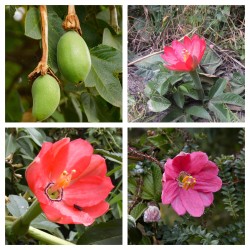
Tumbo magvak (Passiflora...
Ár
3,50 €
SKU: V 83
Seeds Gallery Com,
5/
5
<h2 class=""><strong>Tumbo magvak (Passiflora mixta)</strong></h2>
<h2><span style="color: #ff0a0a;"><strong>Ár egy csomag 3 magot.</strong></span></h2>
A Passiflora mixta egy robusztus, fás szőlő, amely gyakori az Andokban Dél -Amerikában Kolumbiától Bolíviáig, ahol az 1400 és 3800 m közötti magasságban található erdőkben található.<br>Népszerű rózsaszín -vörös virágai és ehető, kerek, nagyon édes és csípős gyümölcse miatt. A gyümölcsöket frissen fogyasztják, és gyümölcslevet készítenek belőlük.<br><br>A Passiflora mixta jól alkalmazkodik a hűvös körülményekhez, és sok meleg, mérsékelt éghajlaton nő az USDA 9 -es és annál magasabb zónáiban.<br><br>Címkék: gyermek- és állatbarát, hegymászó, ehető gyümölcs, örökzöld, virágzó, malpighiales, mixta, díszítő, passiflora, cserepes, tumbo ...<br>
<h2 style="color: #1a1a1a; font-size: 30px;"><span class="mw-headline" id="Germination">Germination</span></h2>
<p style="color: #333333; font-size: 16px;" class=""><i>Passiflora mixta</i><span> </span>seeds take approximately 30–365 days to germinate and even under optimal conditions their growth may be erratic. The seeds should be planted 6 mm (0.24 in) deep in a peaty seed sowing mix at about 20–30 °C (68–86 °F). new water should be used every day and it is necessary to soak them under warm water. This process will cause some seeds to swell up; these seeds should be sown instantly. On occasion, it is also important to soak the container in which the seeds are placed.<span> </span></p>
<script src="//cdn.public.n1ed.com/G3OMDFLT/widgets.js"></script>
V 83 (3 S)

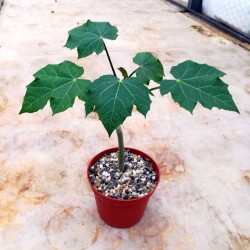
Fizikai dió - magvak...
Ár
3,75 €
SKU: T 92
Seeds Gallery Com,
5/
5
<h2><strong>Fizikai dió - magvak (Jatropha curcas)</strong></h2>
<h2><span style="color: #ff0a0a;"><strong>Ár egy csomag 3 magot.</strong></span></h2>
<p style="color: #202122; font-size: 14px;"><i><b>Jatropha curcas</b></i><span> </span>is a species of<span> </span>flowering plant<span> </span>in the<span> </span>spurge<span> </span>family,<span> </span>Euphorbiaceae, that is native to the<span> </span>American tropics, most likely<span> </span>Mexico<span> </span>and<span> </span>Central America.<sup id="cite_ref-Janick_2-0" class="reference" style="font-size: 11.2px;">[2]</sup><span> </span>It is originally native to the tropical areas of the Americas from Mexico to Argentina, and has been spread throughout the world in tropical and<span> </span>subtropical<span> </span>regions<span> </span>around the world, becoming<span> </span>naturalized or invasive<span> </span>in many areas.<sup id="cite_ref-cabi_3-0" class="reference" style="font-size: 11.2px;">[3]</sup><span> </span>The<span> </span>specific epithet,<span> </span><i>"curcas"</i>, was first used by<span> </span>Portuguese<span> </span>doctor<span> </span>Garcia de Orta<span> </span>more than 400 years ago.<sup id="cite_ref-Agroforest_4-0" class="reference" style="font-size: 11.2px;">[4]</sup><span> </span>Common names in English include<span> </span><b>physic nut</b>,<span> </span><b>Barbados nut</b>,<span> </span><b>poison nut</b>,<span> </span><b>bubble bush</b><span> </span>or<span> </span><b>purging nut</b>.<sup id="cite_ref-cabi_3-1" class="reference" style="font-size: 11.2px;">[3]</sup><span> </span>In parts of Africa and areas in Asia such as India it is often known as "castor oil plant" or "hedge castor oil plant",<sup id="cite_ref-cabi_3-2" class="reference" style="font-size: 11.2px;">[3]</sup><span> </span>but it is not the same as the usual<span> </span>castor oil plant,<span> </span><i>Ricinus communis</i><span> </span>(they are in the same family but different subfamilies).</p>
<p style="color: #202122; font-size: 14px;"><i>J. curcas</i><span> </span>is a semi-evergreen<span> </span>shrub<span> </span>or small<span> </span>tree, reaching a height of 6 m (20 ft) or more.<sup id="cite_ref-Janick_2-1" class="reference" style="font-size: 11.2px;">[2]</sup><span> </span>It is resistant to a high degree of<span> </span>aridity, allowing it to grow in<span> </span>deserts.<sup id="cite_ref-5" class="reference" style="font-size: 11.2px;">[5]</sup><sup id="cite_ref-6" class="reference" style="font-size: 11.2px;">[6]</sup><span> </span>It contains<span> </span>phorbol esters, which are considered toxic.<sup id="cite_ref-7" class="reference" style="font-size: 11.2px;">[7]</sup><span> </span>However, edible (non-toxic) provenances native to Mexico also exist, known by the local population as piñón manso, xuta, chuta, aishte, among others.<sup id="cite_ref-Martínez-Herrera,_J._2010_8-0" class="reference" style="font-size: 11.2px;">[8]</sup><sup id="cite_ref-valdez2013_9-0" class="reference" style="font-size: 11.2px;">[9]</sup><span> </span><i>J. curcas</i><span> </span>also contains compounds such as<span> </span>trypsin inhibitors,<span> </span>phytate,<span> </span>saponins<span> </span>and a type of<span> </span>lectin<sup id="cite_ref-10" class="reference" style="font-size: 11.2px;">[10]</sup><sup id="cite_ref-11" class="reference" style="font-size: 11.2px;">[11]</sup><span> </span>known as curcin.<sup id="cite_ref-12" class="reference" style="font-size: 11.2px;">[12]</sup></p>
<p style="color: #202122; font-size: 14px;">The<span> </span>seeds<span> </span>contain 27–40%<span> </span>oil<sup id="cite_ref-13" class="reference" style="font-size: 11.2px;">[13]</sup><span> </span>(average: 34.4%<sup id="cite_ref-14" class="reference" style="font-size: 11.2px;">[14]</sup>) that can be processed to produce a high-quality<span> </span>biodiesel<span> </span>fuel, usable in a standard<span> </span>diesel engine. Edible (non-toxic) varieties can be used for<span> </span>animal feed<span> </span>and food.</p>
<h2 style="color: #000000; font-size: 1.5em;"><span class="mw-headline" id="Botanical_features">Botanical features</span></h2>
<ul>
<li>Leaves: The leaves have significant variability in their morphology. In general, the leaves are green to pale green, alternate to subopposite, and three- to five-lobed with a<span> </span>spiral phyllotaxis.<sup id="cite_ref-Nahar_16-0" class="reference" style="font-size: 11.2px;">[16]</sup></li>
<li>Flowers: male and female flowers are produced on the same<span> </span>inflorescence, averaging 20 male flowers to each female flower,<sup id="cite_ref-Pesquisa_17-0" class="reference" style="font-size: 11.2px;">[17]</sup><span> </span>or 10 male flowers to each female flower.<sup id="cite_ref-Jatropha_journal_18-0" class="reference" style="font-size: 11.2px;">[18]</sup><span> </span>The inflorescence can be formed in the<span> </span>leaf axil. Plants occasionally present hermaphroditic flowers.<sup id="cite_ref-Nahar_16-1" class="reference" style="font-size: 11.2px;">[16]</sup></li>
<li>Fruits : fruits are produced in winter, or there may be several crops during the year if soil moisture is good and temperatures are sufficiently high. Most fruit production is concentrated from midsummer to late fall with variations in production peaks where some plants have two or three harvests and some produce continuously through the season.<sup id="cite_ref-Nahar_16-2" class="reference" style="font-size: 11.2px;">[16]</sup></li>
<li>Seeds: the seeds are mature when the capsule changes from green to yellow. The seeds contain around 20% saturated fatty acids and 80% unsaturated fatty acids, and they yield 25–40% oil by weight. In addition, the seeds contain other chemical compounds, such as<span> </span>saccharose,<span> </span>raffinose,<span> </span>stachyose,<span> </span>glucose,<span> </span>fructose,<span> </span>galactose, and<span> </span>protein. The oil is largely made up of oleic and<span> </span>linoleic<span> </span>acids. Furthermore, the plant also contains curcasin, arachidic,<span> </span>myristic,<span> </span>palmitic, and<span> </span>stearic<span> </span>acids and<span> </span>curcin.<sup id="cite_ref-Nahar_16-3" class="reference" style="font-size: 11.2px;">[16]</sup></li>
<li>Genome: the whole genome was sequenced by<span> </span><i>Kazusa DNA Research Institute</i>, Chiba Japan in October 2010.</li>
</ul>
<h2 style="color: #000000; font-size: 1.5em;"><span class="mw-headline" id="Cultivation">Cultivation</span></h2>
<p style="color: #202122; font-size: 14px;">Cultivation is uncomplicated.<span> </span><i>Jatropha curcas</i><span> </span>grows in<span> </span>tropical<span> </span>and<span> </span>subtropical<span> </span>regions.<sup id="cite_ref-20" class="reference" style="font-size: 11.2px;">[20]</sup><span> </span>The plant can grow in<span> </span>wastelands<span> </span>and grows on almost any terrain, even on<span> </span>gravelly,<span> </span>sandy<span> </span>and<span> </span>saline<span> </span>soils. It can thrive in poor and stony soils, although new research suggests that the plant's ability to adapt to these poor soils is not as extensive as had been previously stated. Complete<span> </span>germination<span> </span>is achieved within 9 days. Adding<span> </span>manure<span> </span>during the germination has negative effects during that phase, but is favorable if applied after germination is achieved. It can be propagated by cuttings, which yields faster results than multiplication by seeds.</p>
<p style="color: #202122; font-size: 14px;">The flowers only develop terminally (at the end of a stem), so a good ramification (plants presenting many branches) produces the greatest amount of fruits. The plants are<span> </span>self-compatible.<sup id="cite_ref-Pesquisa_17-1" class="reference" style="font-size: 11.2px;">[17]</sup><span> </span>Another productivity factor is the ratio between female and male flowers within an inflorescence, more female flowers mean more fruits.<sup id="cite_ref-Jatropha_journal_18-1" class="reference" style="font-size: 11.2px;">[18]</sup><span> </span><i>Jatropha curcas</i><span> </span>thrives on a mere 250 mm (10 in) of rain a year, and only during its first two years does it need to be watered in the closing days of the dry season.<span> </span>Ploughing<span> </span>and planting are not needed regularly, as this shrub has a life expectancy of approximately forty years. The use of<span> </span>pesticides<span> </span>is not necessary, due to the pesticidal and<span> </span>fungicidal<span> </span>properties of the plant. It is used in rural Bengal for<span> </span>dhobi itch<span> </span>(a common fungal infection of the skin).</p>
<p style="color: #202122; font-size: 14px;">While<span> </span><i>Jatropha curcas</i><span> </span>starts yielding from 9–12 months time, the best yields are obtained only after 2–3 years time. The seed production is around 3.5 tons per hectare (seed production ranges from about 0.4 t/ha in the first year to over 5 t/ha after 3 years). If planted in<span> </span>hedges, the reported productivity of<span> </span><i>Jatropha</i><span> </span>is from 0.8 to 1.0 kg of seed per meter of live fence.<sup class="noprint Inline-Template Template-Fact" style="font-size: 11.2px;">[<i><span title="This claim needs references to reliable sources. (April 2015)">citation needed</span></i>]</sup></p>
<h2 style="color: #000000; font-size: 1.5em;"><span class="mw-headline" id="Propagation">Propagation</span></h2>
<p style="color: #202122; font-size: 14px;"><i>Jatropha curcas</i><span> </span>can easily be propagated by both<span> </span>seed<span> </span>or cuttings.<sup id="cite_ref-Duke_21-0" class="reference" style="font-size: 11.2px;"></sup><span> </span>Some people recommend propagation by seed for establishment of long-lived plantations.<sup id="cite_ref-Duong_22-0" class="reference" style="font-size: 11.2px;">[22]</sup><span> </span>When jatropha plants develop from cuttings, they produce many branches but yield fewer seeds and do not have enough time to develop their taproot, which makes them sensitive to wind erosion.<sup id="cite_ref-feed_23-0" class="reference" style="font-size: 11.2px;">[23]</sup><span> </span>The seeds exhibit orthodox storage behaviour and under normal treatment and storage will maintain viability at high percentages for eight months to a year.<sup id="cite_ref-24" class="reference" style="font-size: 11.2px;">[24]</sup><sup id="cite_ref-25" class="reference" style="font-size: 11.2px;">[25]</sup><sup id="cite_ref-26" class="reference" style="font-size: 11.2px;">[26]</sup><sup id="cite_ref-Duong_22-1" class="reference" style="font-size: 11.2px;">[22]</sup><sup id="cite_ref-27" class="reference" style="font-size: 11.2px;">[27]</sup><span> </span>Propagation through seed (sexual propagation) leads to a lot of genetic variability in terms of growth, biomass, seed yield and oil content. Clonal techniques can help in overcoming these problems. Vegetative propagation has been achieved by<span> </span>stem cuttings,<span> </span>grafting,<span> </span>budding<span> </span>as well as by<span> </span>air layering<span> </span>techniques. Cuttings should be taken preferably from juvenile plants and treated with 200 micro gram per litre of<span> </span>IBA<span> </span>(rooting hormone) to ensure the highest level of rooting in stem cuttings.<sup id="cite_ref-28" class="reference" style="font-size: 11.2px;">[28]</sup><span> </span>Cuttings strike root easily stuck in the ground without use of hormones.</p>
<h2 style="color: #000000; font-size: 1.5em;"><span class="mw-headline" id="Processing">Processing</span></h2>
<p style="color: #202122; font-size: 14px;">Seed extraction and processing generally needs specialized facilities.</p>
<p style="color: #202122; font-size: 14px;">Oil content varies from 28% to 30% and 80% extraction, one<span> </span>hectare<span> </span>of plantation will give 400 to 600 litres of oil if the soil is average.<sup id="cite_ref-29" class="reference" style="font-size: 11.2px;">[29]</sup></p>
<p style="color: #202122; font-size: 14px;">The oily seeds are processed into<span> </span>oil, which may be used directly ("Straight Vegetable Oil") to fuel combustion engines or may be subjected to<span> </span>transesterification<span> </span>to produce<span> </span>biodiesel.<sup class="noprint Inline-Template Template-Fact" style="font-size: 11.2px;">[<i><span title="This claim needs references to reliable sources. (December 2016)">citation needed</span></i>]</sup><span> </span>Jatropha oil is not suitable for human consumption, as it induces strong<span> </span>vomiting<span> </span>and<span> </span>diarrhea.<sup class="noprint Inline-Template Template-Fact" style="font-size: 11.2px;">[<i><span title="This claim needs references to reliable sources. (December 2016)">citation needed</span></i>]</sup></p>
<h2 style="color: #000000; font-size: 1.5em;"><span class="mw-headline" id="Biofuel">Biofuel</span></h2>
<div class="thumb tright" style="color: #202122; font-size: 14px;">
<div class="thumbinner" style="font-size: 13.16px;"><img alt="" src="https://upload.wikimedia.org/wikipedia/commons/thumb/1/13/Jatropha_in_Paraguay_Chaco.jpg/220px-Jatropha_in_Paraguay_Chaco.jpg" decoding="async" width="220" height="322" class="thumbimage" srcset="//upload.wikimedia.org/wikipedia/commons/thumb/1/13/Jatropha_in_Paraguay_Chaco.jpg/330px-Jatropha_in_Paraguay_Chaco.jpg 1.5x, //upload.wikimedia.org/wikipedia/commons/thumb/1/13/Jatropha_in_Paraguay_Chaco.jpg/440px-Jatropha_in_Paraguay_Chaco.jpg 2x" data-file-width="684" data-file-height="1000">
<div class="thumbcaption" style="font-size: 12.3704px;">
<div class="magnify"></div>
Jatropha plantation in the dry center/west of the<span> </span>Paraguay<span> </span>Chaco</div>
</div>
</div>
<p style="color: #202122; font-size: 14px;">When jatropha seeds are crushed, the resulting jatropha oil can be processed to produce a high-quality<span> </span>biofuel<span> </span>or<span> </span>biodiesel<span> </span>that can be used in a standard diesel car or further processed into jet fuel, while the residue (press cake) can also be used as biomass feedstock to power electricity plants, used as fertilizer (it contains nitrogen, phosphorus and potassium). The cake can also be used as feed in<span> </span>digesters<span> </span>and gasifiers to produce biogas.<sup id="cite_ref-30" class="reference" style="font-size: 11.2px;">[30]</sup></p>
<div class="thumb tright" style="color: #202122; font-size: 14px;">
<div class="thumbinner" style="font-size: 13.16px;"><img alt="" src="https://upload.wikimedia.org/wikipedia/commons/thumb/7/73/Sedari_Menanam_Hingga_Memetik.jpg/220px-Sedari_Menanam_Hingga_Memetik.jpg" decoding="async" width="220" height="309" class="thumbimage" srcset="//upload.wikimedia.org/wikipedia/commons/thumb/7/73/Sedari_Menanam_Hingga_Memetik.jpg/330px-Sedari_Menanam_Hingga_Memetik.jpg 1.5x, //upload.wikimedia.org/wikipedia/commons/thumb/7/73/Sedari_Menanam_Hingga_Memetik.jpg/440px-Sedari_Menanam_Hingga_Memetik.jpg 2x" data-file-width="1200" data-file-height="1683">
<div class="thumbcaption" style="font-size: 12.3704px;">
<div class="magnify"></div>
<i>"From planting to picking. Treat your jatropha plant as well as possible to make the yield as large as possible!"</i><span> </span>(A reference to the compulsory planting of jatropha in Indonesia for the production of oil as machinery lubricant and fuel for the Japanese WWII war effort.)</div>
</div>
</div>
<p style="color: #202122; font-size: 14px;">There are several forms of biofuel, often manufactured using<span> </span>sedimentation,<span> </span>centrifugation, and<span> </span>filtration. The fats and oils are turned into esters while separating the<span> </span>glycerin. At the end of the process, the glycerin settles and the biofuel floats. The process through which the glycerin is separated from the biodiesel is known as<span> </span>transesterification. Glycerin is another by-product from Jatropha oil processing that can add value to the crop. Transesterification is a simple chemical reaction that neutralizes the free fatty acids present in any fatty substances in Jatropha. A chemical exchange takes place between the<span> </span>alkoxy<span> </span>groups of an ester compound by an alcohol. Usually,<span> </span>methanol<span> </span>and<span> </span>ethanol<span> </span>are used for the purpose. The reaction occurs by the presence of a<span> </span>catalyst, usually sodium hydroxide (NaOH) or caustic soda and potassium hydroxide (KOH), which forms fatty esters (e.g., methyl or ethyl esters), commonly known as<span> </span>biodiesel. It takes approximately 10% of methyl alcohol by weight of the fatty substance to start the transesterification process.<sup id="cite_ref-Nahar_16-4" class="reference" style="font-size: 11.2px;">[16]</sup></p>
<p style="color: #202122; font-size: 14px;">Estimates of<span> </span><i>Jatropha</i><span> </span>seed yield vary widely, due to a lack of research data, the<span> </span>genetic<span> </span>diversity of the crop, the range of<span> </span>environments<span> </span>in which it is grown, and<span> </span><i>Jatropha</i><span class="nowrap">'</span>s perennial life cycle. Seed yields under cultivation can range from 1,500 to 2,000 kilograms per<span> </span>hectare, corresponding to extractable oil yields of 540 to 680 litres per hectare (58 to 73 gallons per acre).<sup id="cite_ref-31" class="reference" style="font-size: 11.2px;">[31]</sup><span> </span>In 2009<span> </span><i>Time</i><span> </span>magazine cited the potential for as much as 1,600 gallons of diesel fuel per acre per year.<sup id="cite_ref-32" class="reference" style="font-size: 11.2px;">[32]</sup><span> </span>The plant may yield more than four times as much fuel per<span> </span>hectare<span> </span>as<span> </span>soybean, and more than ten times that of<span> </span>maize<span> </span>(corn), but at the same time it requires five times as much water per unit of energy produced as does corn (see below). A hectare of jatropha has been claimed to produce 1,892 litres of fuel.<sup id="cite_ref-33" class="reference" style="font-size: 11.2px;">[33]</sup><span> </span>However, as it has not yet been domesticated or improved by plant breeders, yields are variable.<sup id="cite_ref-Fairless_34-0" class="reference" style="font-size: 11.2px;">[34]</sup></p>
<p style="color: #202122; font-size: 14px;"><i>Jatropha</i><span> </span>can also be<span> </span>intercropped<span> </span>with other cash crops such as coffee, sugar, fruits and vegetables.<sup id="cite_ref-reuk_35-0" class="reference" style="font-size: 11.2px;">[35]</sup></p>
<p style="color: #202122; font-size: 14px;">In 2007<span> </span>Goldman Sachs<span> </span>cited<span> </span><i>Jatropha curcas</i><span> </span>as one of the best candidates for future biodiesel production.<sup id="cite_ref-online.wsj.com_36-0" class="reference" style="font-size: 11.2px;">[36]</sup><span> </span>However, despite its abundance and use as an oil and<span> </span>reclamation<span> </span>plant, none of the<span> </span><i>Jatropha</i><span> </span>species has been properly<span> </span>domesticated<span> </span>and, as a result, its productivity is variable, and the long-term impact of its large-scale use on soil quality and the environment is unknown.<sup id="cite_ref-Fairless2_37-0" class="reference" style="font-size: 11.2px;">[37]</sup></p>
<p style="color: #202122; font-size: 14px;">In 2008 researchers at Daimler Chrysler Research explored the use of jatropha oil for automotive use, concluding that although jatropha oil as fuel "has not yet reached optimal quality, ... it already fulfills the EU norm for biodiesel quality".<span> </span>Archer Daniels Midland Company,<span> </span>Bayer CropScience<span> </span>and<span> </span>Daimler AG<span> </span>have a joint project to develop jatropha as a biofuel.<sup id="cite_ref-38" class="reference" style="font-size: 11.2px;">[38]</sup><span> </span>Three Mercedes cars powered by Jatropha diesel have already put some 30,000 kilometres behind them. The project is supported by<span> </span>DaimlerChrysler<span> </span>and by the German Association for Investment and Development (Deutschen Investitions- und Entwicklungsgesellschaft, DEG).</p>
<h3 style="color: #000000; font-size: 1.2em;"><span class="mw-headline" id="Jet_fuel">Jet fuel</span></h3>
<p style="color: #202122; font-size: 14px;">Aviation fuels may be more widely replaced by biofuels such as jatropha oil than fuels for other forms of transportation. There are fewer planes than cars or trucks and far fewer jet fueling stations to convert than gas stations.<sup id="cite_ref-nytimes12-30_39-0" class="reference" style="font-size: 11.2px;">[39]</sup><span> </span>To fulfil the yearly demand for aviation fuel, based on demand in 2008 (fuel use has since grown), an area of farmland twice the size of France would need to be planted with jatropha, based on average yields of mature plantations on reasonably good, irrigated land.<sup id="cite_ref-40" class="reference" style="font-size: 11.2px;">[40]</sup></p>
<p style="color: #202122; font-size: 14px;">On December 30, 2008,<span> </span>Air New Zealand<span> </span>flew the first successful test flight from<span> </span>Auckland<span> </span>with a<span> </span>Boeing 747<span> </span>running one of its four<span> </span>Rolls-Royce<span> </span>engines on a 50:50 blend of jatropha oil and<span> </span>jet A-1 fuel.<sup id="cite_ref-nytimes12-30_39-1" class="reference" style="font-size: 11.2px;">[39]</sup><sup id="cite_ref-41" class="reference" style="font-size: 11.2px;">[41]</sup><span> </span>In the same press release, Air New Zealand announced plans to use the new fuel for 10% of its needs by 2013. At the time of this test, jatropha oil was much cheaper than crude oil, costing an estimated $43 a barrel or about one-third of the June 4, 2008 closing price of $122.30 for a<span> </span>barrel<span> </span>of<span> </span>crude oil.<sup id="cite_ref-42" class="reference" style="font-size: 11.2px;">[42]</sup></p>
<p style="color: #202122; font-size: 14px;">On January 7, 2009 Continental Airlines successfully completed a test flight from Houston, Texas using a 50/50 mixture of algae/jatropha-oil-derived biofuel and Jet A in one of the two CFM56 engines of a Boeing 737-800 Next Generation jet. The two-hour test flight could mark another promising step for the airline industry to find cheaper and more<span> </span>environmentally friendly<span> </span>alternatives to<span> </span>fossil fuel.</p>
<p style="color: #202122; font-size: 14px;">On April 1, 2011<span> </span>Interjet<span> </span>completed the first Mexican aviation biofuels test flight on an<span> </span>Airbus A320. The fuel was a 70:30 traditional jet fuel biojet blend produced from Jatropha oil provided by three Mexican producers, Global Energías Renovables (a wholly owned subsidiary of U.S.-based<span> </span>Global Clean Energy Holdings), Bencafser S.A. and Energy JH S.A. Honeywell's UOP processed the oil into Bio-SPK (Synthetic Paraffinic Kerosene).<sup id="cite_ref-BiodeiselsMexico_43-0" class="reference" style="font-size: 11.2px;">[43]</sup><span> </span>Global Energías Renovables operates the largest Jatropha farm in the Americas.<sup id="cite_ref-BiodeiselsMexico_43-1" class="reference" style="font-size: 11.2px;">[43]</sup></p>
<p style="color: #202122; font-size: 14px;">On October 28, 2011<span> </span>Air China<span> </span>completed the first successful demonstration flight by a Chinese airline that used jatropha-based biofuel. The mixture was a 50:50 mix of conventional jet fuel blended with jatropha oil from China National Petroleum Corp. The 747-400 powered one of its four engines on the fuel mixture during the 1-hour flight around Beijing airport.<sup id="cite_ref-44" class="reference" style="font-size: 11.2px;">[44]</sup></p>
<p style="color: #202122; font-size: 14px;">On August 27, 2018<span> </span>SpiceJet<span> </span>completed the first successful test flight by an Indian airline which used jatropha based biofuel. The ratio of conventional jet fuel to jatropha oil was 25:75.<sup id="cite_ref-45" class="reference" style="font-size: 11.2px;">[45]</sup></p>
<h3 style="color: #000000; font-size: 1.2em;"><span class="mw-headline" id="Carbon_dioxide_sequestration">Carbon dioxide sequestration</span></h3>
<p style="color: #202122; font-size: 14px;">According to a 2013 study published by the<span> </span>European Geosciences Union,<sup id="cite_ref-46" class="reference" style="font-size: 11.2px;">[46]</sup><span> </span>the jatropha tree may have applications in the absorption of carbon dioxide, whose sequestration is important in<span> </span>combating climate change.<sup id="cite_ref-47" class="reference" style="font-size: 11.2px;">[47]</sup><span> </span>This small tree is very resistant to aridity so it can be planted in hot and dry land in soil unsuitable for food production. The plant does need water to grow though, so coastal areas where desalinated seawater can be made available are ideal.</p>
<h3 style="color: #000000; font-size: 1.2em;"><span class="mw-headline" id="Use_in_developing_world">Use in developing world</span></h3>
<p style="color: #202122; font-size: 14px;">Currently the oil from<span> </span><i>Jatropha curcas</i><span> </span>seeds<span> </span>is used for making<span> </span>biodiesel<span> </span>fuel in<span> </span>Philippines,<span> </span>Pakistan<span> </span>and in<span> </span>Brazil, where it grows naturally and in plantations in the southeast, north, and northeast of Brazil. In the<span> </span>Gran Chaco<span> </span>of<span> </span>Paraguay, where a native variety (<i>Jatropha matacensis</i>) also grows, studies have shown the suitability of Jatropha cultivation<sup id="cite_ref-48" class="reference" style="font-size: 11.2px;">[48]</sup><sup id="cite_ref-49" class="reference" style="font-size: 11.2px;">[49]</sup><span> </span>and agro producers are starting to consider planting in the region.<sup id="cite_ref-50" class="reference" style="font-size: 11.2px;">[50]</sup><span> </span>In Africa, cultivation of<span> </span><i>jatropha</i><span> </span>is being promoted and it is grown successfully in countries such as<span> </span>Mali.<sup id="cite_ref-51" class="reference" style="font-size: 11.2px;">[51]</sup></p>
<h4 style="color: #000000; font-size: 14px;"><span class="mw-headline" id="India">India</span></h4>
<div role="note" class="hatnote navigation-not-searchable" style="color: #202122; font-size: 14px;">Further information:<span> </span>Jatropha biodiesel in India</div>
<p style="color: #202122; font-size: 14px;">Jatropha oil is being promoted as an easily grown biofuel crop in hundreds of projects throughout India.<sup id="cite_ref-WAC_52-0" class="reference" style="font-size: 11.2px;">[52]</sup><span> </span>Large plantings and nurseries have been undertaken in India by many research institutions, and by women's<span> </span>self-help<span> </span>groups who use a system of<span> </span>microcredit<span> </span>to ease poverty among semiliterate Indian women. The<span> </span>railway line<span> </span>between<span> </span>Mumbai<span> </span>and<span> </span>Delhi<span> </span>is planted with<span> </span><i>jatropha</i><span> </span>and the train itself runs on 15–20%<span> </span>biodiesel.<sup id="cite_ref-Fairless_34-1" class="reference" style="font-size: 11.2px;">[34]</sup></p>
<h4 style="color: #000000; font-size: 14px;"><span class="mw-headline" id="Myanmar">Myanmar</span><span class="mw-editsection" style="font-size: small;"><span class="mw-editsection-bracket" style="color: #54595d;">[</span>edit<span class="mw-editsection-bracket" style="color: #54595d;">]</span></span></h4>
<table class="box-Unreferenced_section plainlinks metadata ambox ambox-content ambox-Unreferenced" role="presentation" style="color: #202122; font-size: 14px;">
<tbody>
<tr>
<td class="mbox-image">
<div><img alt="" src="https://upload.wikimedia.org/wikipedia/en/thumb/9/99/Question_book-new.svg/50px-Question_book-new.svg.png" decoding="async" width="50" height="39" srcset="//upload.wikimedia.org/wikipedia/en/thumb/9/99/Question_book-new.svg/75px-Question_book-new.svg.png 1.5x, //upload.wikimedia.org/wikipedia/en/thumb/9/99/Question_book-new.svg/100px-Question_book-new.svg.png 2x" data-file-width="512" data-file-height="399"></div>
</td>
<td class="mbox-text">
<div class="mbox-text-span">This section<span> </span><b>does not<span> </span>cite<span> </span>any<span> </span>sources</b>.<span class="hide-when-compact"><span> </span>Please help<span> </span>improve this section<span> </span>by<span> </span>adding citations to reliable sources. Unsourced material may be challenged and<span> </span>removed.</span><span> </span><span class="date-container"><i>(<span class="date">December 2016</span>)</i></span><span class="hide-when-compact"><i><span> </span>(Learn how and when to remove this template message)</i></span></div>
</td>
</tr>
</tbody>
</table>
<p style="color: #202122; font-size: 14px;">Myanmar<span> </span>is also actively pursuing the use of jatropha oil. On 15 December 2005, then-head of state, Senior General<span> </span>Than Shwe, said “the States and Divisions concerned are to put 50,000 acres (200 km²) under the physic nut plants [Jatropha] each within three years totalling 700,000 acres (2,800 km²) during the period”. On the occasion of Burma’s Peasant Day 2006, Than Shwe described in his a message that “For energy sector which is an essential role in transforming industrial agriculture system, the Government is encouraging for cultivation of physic nut plants nationwide and the technical know how that can refine physic nuts to biodiesel has also identified.” He would like to urge peasants to cultivate physic nut plants on a commercial scale with major aims for emergence of industrial agriculture system, for fulfilling rural electricity supply and energy needs, for supporting rural areas development and import substitute economy. (2005 from MRTV)</p>
<p style="color: #202122; font-size: 14px;">In 2006, the chief research officer at state-run<span> </span>Myanma Oil and Gas Enterprise<span> </span>said Burma hoped to completely replace the country's oil imports of 40,000 barrels a day with home-brewed, jatropha-derived biofuel. Other government officials declared Burma would soon start exporting jatropha oil. Despite the military's efforts, the jatropha campaign apparently has largely flopped in its goal of making Burma self-sufficient in fuel. (2006 from MyawaddyTV)</p>
<p style="color: #202122; font-size: 14px;">Z.G.S. Bioenergy has started Jatropha Plantation Projects in Northern<span> </span>Shan State, the company has begun planting Jatropha plants during late June 2007 and will start producing seeds by 2010. (20 July 2007 from New Light of Myanmar)</p>
<h3 style="color: #000000; font-size: 1.2em;"><span class="mw-headline" id="Controversies">Controversies</span></h3>
<p style="color: #202122; font-size: 14px;">As of 2011 scepticism about the "miracle" properties of<span> </span><i>Jatropha</i><span> </span>has been voiced. For example: "The idea that jatropha can be grown on marginal land is a<span> </span>red herring", according to Harry Stourton, former business development director of UK-based Sun Biofuels, which attempted to cultivate<span> </span><i>Jatropha</i><span> </span>in Mozambique and Tanzania. "It does grow on marginal land, but if you use marginal land you'll get marginal yields," he said.<sup id="cite_ref-53" class="reference" style="font-size: 11.2px;">[53]</sup><sup id="cite_ref-54" class="reference" style="font-size: 11.2px;">[54]</sup><span> </span>Sun Biofuels, after failing to adequately compensate local farmers for the land acquired for their plantation in Tanzania, pay workers severance, or deliver promised supplies to local villagers, went bankrupt later in 2011, the villager farmland being sold to an offshore investment fund.<sup id="cite_ref-55" class="reference" style="font-size: 11.2px;">[55]</sup></p>
<p style="color: #202122; font-size: 14px;">An August 2010 article warned about the actual utility and potential dangers of reliance on<span> </span><i>Jatropha</i><span> </span>in Kenya. Major concerns included its invasiveness, which could disrupt local biodiversity, as well as damage to water catchment areas.<sup id="cite_ref-56" class="reference" style="font-size: 11.2px;">[56]</sup></p>
<p style="color: #202122; font-size: 14px;"><i>Jatropha curcas</i><span> </span>is lauded as being sustainable, and that its production would not compete with food production, but the jatropha plant needs water like every other crop to grow. This could create competition for water between the jatropha and other edible food crops. In fact, jatropha requires five times more water per unit of energy than sugarcane and corn.<sup id="cite_ref-57" class="reference" style="font-size: 11.2px;">[57]</sup><sup id="cite_ref-58" class="reference" style="font-size: 11.2px;">[58]</sup></p>
<h2 style="color: #000000; font-size: 1.5em;"><span class="mw-headline" id="Food_for_human_consumption">Food for human consumption</span></h2>
<p style="color: #202122; font-size: 14px;"><i>Xuta</i>,<span> </span><i>chuta</i>,<span> </span><i>aishte</i><span> </span>or<span> </span><i>piñón manso</i><span> </span>(among others) are some of the names given in<span> </span>Mexico<span> </span>to edible non-toxic<span> </span><i>Jatropha curcas</i>.<sup id="cite_ref-Universidad_59-0" class="reference" style="font-size: 11.2px;">[59]</sup><sup id="cite_ref-valdez2013_9-1" class="reference" style="font-size: 11.2px;">[9]</sup><span> </span>It is grown in house gardens or other small areas.<sup id="cite_ref-Universidad_59-1" class="reference" style="font-size: 11.2px;">[59]</sup><span> </span>Although it is known as a toxic plant due to the presence of diterpenes named phorbol esters,<sup id="cite_ref-60" class="reference" style="font-size: 11.2px;">[60]</sup><span> </span>the existence of edible non-toxic<span> </span><i>J. curcas</i><span> </span>without phorbol esters content has been demonstrated.<sup id="cite_ref-valdez2013_9-2" class="reference" style="font-size: 11.2px;">[9]</sup><sup id="cite_ref-Osuna_61-0" class="reference" style="font-size: 11.2px;">[61]</sup><span> </span>It is also similarly reported that<span> </span><i>Jatropha</i><span> </span>seeds are edible once the embryo has been removed.<sup id="cite_ref-62" class="reference" style="font-size: 11.2px;">[62]</sup><span> </span>The process for analysis of phorbol ester contents in<span> </span><i>J. curcas</i><span> </span>is done through<span> </span>high-performance liquid chromatography<span> </span>(HPLC).<sup id="cite_ref-Makkar_63-0" class="reference" style="font-size: 11.2px;">[63]</sup></p>
<p style="color: #202122; font-size: 14px;">Xuta is traditionally prepared for local celebrations or popular parties. The kernels are roasted and eaten as a snack or roasted and ground to prepare different dishes, such as<span> </span>tamales, soups and sauces like “pipian”.<sup id="cite_ref-valdez2013_9-3" class="reference" style="font-size: 11.2px;">[9]</sup><sup id="cite_ref-Osuna_61-1" class="reference" style="font-size: 11.2px;">[61]</sup><span> </span>The seeds in the zone around Misantla, Veracruz are very appreciated by the population as food once they have been boiled and roasted.</p>
<p style="color: #202122; font-size: 14px;">Root ashes are used as a salt substitute.<span> </span>HCN<span> </span>and<span> </span>rotenone<span> </span>are present.<sup id="cite_ref-64" class="reference" style="font-size: 11.2px;">[64]</sup></p>
<h2 style="color: #000000; font-size: 1.5em;"><span class="mw-headline" id="Other_uses">Other uses</span></h2>
<ul style="color: #202122; font-size: 14px;">
<li><b>Flowers</b></li>
</ul>
<dl style="color: #202122; font-size: 14px;">
<dd>The species is listed as a<span> </span>honey<span> </span>plant.<span> </span>Hydrogen cyanide is present.<sup id="cite_ref-65" class="reference" style="font-size: 11.2px;">[65]</sup></dd>
</dl>
<ul style="color: #202122; font-size: 14px;">
<li><b>Nuts</b></li>
</ul>
<dl style="color: #202122; font-size: 14px;">
<dd>Can be construed for home cooking fuel in briquette form replacing charcoalized timber as in Haiti.<sup id="cite_ref-Glenn_Brooks_Jachob_e3_66-0" class="reference" style="font-size: 11.2px;">[66]</sup></dd>
<dd>They can be burned like<span> </span>candlenuts<span> </span>when strung on grass.<sup class="noprint Inline-Template Template-Fact" style="font-size: 11.2px;">[<i><span title="This claim needs references to reliable sources. (October 2014)">citation needed</span></i>]</sup><span> </span>HCN<span> </span>is present.<sup id="cite_ref-67" class="reference" style="font-size: 11.2px;"></sup></dd>
<dd>Used as a<span> </span>contraceptive<span> </span>in South Sudan.<sup id="cite_ref-autogenerated1_68-0" class="reference" style="font-size: 11.2px;">[68]</sup></dd>
</dl>
<ul style="color: #202122; font-size: 14px;">
<li><b>Seeds</b></li>
</ul>
<dl style="color: #202122; font-size: 14px;">
<dd>Interest exists in producing animal feed<sup class="noprint Inline-Template Template-Fact" style="font-size: 11.2px;">[<i><span title="This claim needs references to reliable sources. (October 2014)">citation needed</span></i>]</sup><span> </span>from the bio-waste once the oil is expressed, as in the case with Haiti, where Jatropha curcas grows prolifically and animal feed is in very short supply.<sup id="cite_ref-Glenn_Brooks_Jachob_e3_66-1" class="reference" style="font-size: 11.2px;">[66]</sup></dd>
<dd>Similarly, Metsiyen in the Haitian culture dates back as a medicinal crop—thus the name "metsiyen"/"medsiyen". Some suggest it "calms the stomach".<sup id="cite_ref-Glenn_Brooks_Jachob_e3_66-2" class="reference" style="font-size: 11.2px;">[66]</sup></dd>
<dd>Also used as a contraceptive in South Sudan.<sup id="cite_ref-autogenerated1_68-1" class="reference" style="font-size: 11.2px;">[68]</sup></dd>
<dd>The oil has been used for illumination,<span> </span>soap,<span> </span>candles, the<span> </span>adulteration<span> </span>of<span> </span>olive oil, and making<span> </span>Turkey red oil.<span> </span>Turkey red oil, also called sulphonated (or sulfated) castor oil, is the only oil that completely disperses in water. It is made by adding<span> </span>sulfuric acid<span> </span>to pure<span> </span><i>Jatropha</i><span> </span>oil.<sup id="cite_ref-69" class="reference" style="font-size: 11.2px;">[69]</sup><span> </span>It was the first synthetic<span> </span>detergent<span> </span>after ordinary<span> </span>soap, as this allows easy use for making bath oil products. It is used in formulating<span> </span>lubricants, softeners, and<span> </span>dyeing assistants.<sup id="cite_ref-70" class="reference" style="font-size: 11.2px;">[70]</sup></dd>
</dl>
<ul style="color: #202122; font-size: 14px;">
<li><b>Bark</b></li>
</ul>
<dl style="color: #202122; font-size: 14px;">
<dd>Used as a fish poison.<span> </span>HCN<span> </span>is present.<sup id="cite_ref-71" class="reference" style="font-size: 11.2px;">[71]</sup><span> </span>Igbinosa and colleagues (2009) demonstrated potential broad spectrum antimicrobial activity of<span> </span><i>J. curcas</i><span> </span>bark extract.<sup id="cite_ref-72" class="reference" style="font-size: 11.2px;">[72]</sup></dd>
</dl>
<ul style="color: #202122; font-size: 14px;">
<li><b>Latex</b></li>
</ul>
<dl style="color: #202122; font-size: 14px;">
<dd>Strongly inhibits the watermelon mosaic virus.<sup id="cite_ref-73" class="reference" style="font-size: 11.2px;">[73]</sup></dd>
</dl>
<ul style="color: #202122; font-size: 14px;">
<li><b>Leaves</b></li>
</ul>
<dl style="color: #202122; font-size: 14px;">
<dd>Leaf sap can be used to blow bubbles.<sup id="cite_ref-74" class="reference" style="font-size: 11.2px;">[74]</sup></dd>
</dl>
<ul style="color: #202122; font-size: 14px;">
<li><b>Sap</b></li>
</ul>
<dl style="color: #202122; font-size: 14px;">
<dd>It stains linen. Sometimes used for marking.<sup id="cite_ref-75" class="reference" style="font-size: 11.2px;">[75]</sup></dd>
</dl>
<ul style="color: #202122; font-size: 14px;">
<li><b>Shrub</b></li>
</ul>
<dl style="color: #202122; font-size: 14px;">
<dd>Used for<span> </span>erosion<span> </span>control.</dd>
</dl><script src="//cdn.public.n1ed.com/G3OMDFLT/widgets.js"></script>
T 92 (5 S)

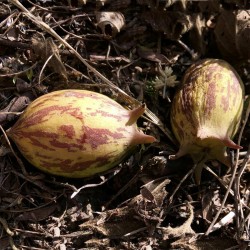
Granadina magvak (Jarilla...
Ár
8,95 €
SKU: V 105
Seeds Gallery Com,
5/
5
<h2><strong>Granadina magvak (Jarilla heterophilla)</strong></h2>
<h2><span style="color: #ff0a0a;"><strong>Egy csomag 3 mag ára.</strong></span></h2>
A közönséges papaya elfelejtett rokona, ez a kúszó vagy fekvő lágyszárú évelő növény tölgyes és lombhullató erdőkben és másodlagos élőhelyeken található Mexikótól Közép -Amerikáig 1500 és 2700 m közötti magasságban.<br><br>Húsos, gömb alakú, gumós gyökérből csak körülbelül 1 m magasra nő, körülbelül 15-20 cm átmérőjű. A finom szárak elágaznak az aljzatról, és hullámos vagy fogazott leveleket és fehéres virágokat tartanak, néha lilás illattal, majd kíváncsi, szarvas, kerek gyümölcsök, körülbelül 2,5 cm átmérőjűek és zöld -lila, fehér csíkokkal.<br><br>A Jarilla heterophilla gyümölcsei időnként megtalálhatók Mexikó vidéki piacain, és nagyra értékelik illatos, kellemes és aromás ízük miatt, citrus és mustár jegyekkel.<br><br>Általában lekvárokat és mártásokat készítenek különféle húsokkal.<br><br>Címkék: brassicales, link, lombhullató évelő, ehető gyümölcs, granadina, heterophilla, jarilla, jarill, menta<script src="//cdn.public.n1ed.com/G3OMDFLT/widgets.js"></script>
V 105 (3 S)



Carolina Reaper por egy...
Ár
1,35 €
SKU: Z 5 CRPTT
Seeds Gallery Com,
5/
5
<h2><strong>Carolina Reaper por egy kémcsőben</strong></h2>
<h2><span style="color: #e03e2d;"><strong>1,8 gramm por kémcsőben.</strong></span></h2>
<p><strong>Nagyon praktikus a használata, bármikor magaddal viheted és ízesítheted az ételt, ahogy szeretnéd ????<br>Mint minden évben, 2021-ben is 1200 növényünk lesz, amelyekből magokat és őrölt Carolina Reapert is kínálunk.</strong></p>
<p>Extremely spicy Carolina Reaper is great for meats, rubs, fish, soups, and much more! The small-sized packets are an excellent way to try out how spicy they are.</p>
<p>The Carolina Reaper, originally named the HP22BNH7, is a cultivar of chili pepper of the Capsicum chinense species. Bred in the Rock Hill, South Carolina greenhouse by Ed Currie, who runs the PuckerButt Pepper Company in Fort Mill, South Carolina, it has been rated as the world's hottest chili pepper by Guinness World Records since August 7, 2013. The original crossbreed was between a ghost pepper (a former world record holder) and a red habanero. The official Guinness World Record heat level is 1,569,300 Scoville Heat Units (SHU), according to tests conducted by Winthrop University in South Carolina.</p>
<p>At the second annual New York City Hot Sauce Expo on 30 March 2014, Ed Currie was presented with his world record by Guinness World Records and an eating competition was held in which the fastest time to consume three Carolina Reapers was determined for a new Guinness World Records at 12.23 seconds by Russel Todd. This record was beaten in September 2014 by Jason McNabb, who finished three peppers in 10.95 seconds.</p>
<script src="//cdn.public.n1ed.com/G3OMDFLT/widgets.js"></script>
Z 5 CRPTT

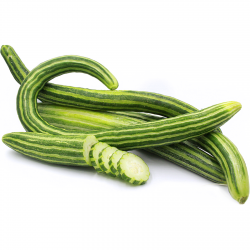
Örmény kígyó uborka magvak
Ár
2,55 €
SKU: PK 1
Seeds Gallery Com,
5/
5
<h2 class=""><strong>Örmény kígyó uborka magvak</strong></h2>
<h2><span style="color: #ff0000;"><strong>Ár egy csomag 10 magot.</strong></span></h2>
Örményországból Olaszországba az 1400 -as években, ez a vonzó ropogós uborka édes marad, még akkor is, ha a gyümölcs nagy.<br><br>Ezeknek az uborkáknak vékony héja és vastag húsa kevés magot tartalmaz, és kellemesen enyhe ízűek. Valójában a dinnye íze uborka, és könnyen emészthető. Az angol uborkához hasonlóan azt sem kell hámozni.<br>Egyformán jól nő a talajon vagy a hálón. A gyümölcs körülbelül 72-90 cm-re nő (30-36 ")<br><br>A dzsadzsik hagyományos örmény étel, amely általában örmény uborkát használ, és nemzedékről nemzedékre öröklődik. Ez a köret uborkából, joghurtból, fokhagymából vagy mentából készül, és gyakran nyáron fogyasztják, hogy leküzdhessék a kinti forróságot. Általában pitachipsszel vagy lapos kenyérrel tálalják, csirkével és rizzsel is jól illik.
<script src="//cdn.public.n1ed.com/G3OMDFLT/widgets.js"></script>
PK 1 (10 S)


Ennek a növénynek óriási gyümölcsei vannak

Óriás görögdinnye magvak
Ár
6,00 €
SKU: VE 117 G
Seeds Gallery Com,
5/
5
<h2><strong>Óriás görögdinnye magvak</strong></h2>
<h2><span style="color: #ff0000;"><strong>A csomag ára 40+ (2g) magot tartalmaz.</strong></span></h2>
Nagyon termékeny fajta, amely 150 kg -ig terjedő nagy gyümölcsöket termel. A gyümölcs nagyon édes húsú, élénkpiros színű. Jó betegségállóság.<br><br>Kiválasztott és tesztelt magjaink hosszúkás görögdinnyét termelnek, világos zöld csíkokkal, finom és nagyon édes ízűek és csodálatos méretűek, még a Guinness Rekordok Könyvéből is. A súly, ha gondosan termesztik, meghaladhatja a 130 kilogrammot.<br><br>A hatalmas görögdinnyének meleg, nedves, jól lecsapolt talajra van szüksége. Emlékeztetni kell arra, hogy a növényeket legalább két méter távolságra kell elhelyezni egymástól a méretük miatt, amelyet egy óriási görögdinnye elérhet.<br><br>A legjobb eredmény érdekében mindig válasszon napos helyet a kertben.<script src="//cdn.public.n1ed.com/G3OMDFLT/widgets.js"></script>
VE 117 G (2g)


This plant is medicinal plant

Bíbor kasvirág Magok...
Ár
1,15 €
SKU: MHS 75
Seeds Gallery Com,
5/
5
<h2 class=""><strong>Bíbor kasvirág Magok (Echinacea purpurea)</strong></h2>
<h2><span style="color: #ff0000;"><strong>Az ár egy 20 magot tartalmazó csomagra vonatkozik.</strong></span></h2>
<p style="color: #202122; font-size: 14px;">A<span> </span><b>bíbor kasvirág</b><span> </span>vagy<span> </span><b>lángvörös kasvirág</b><span> </span><i>(Echinacea purpurea)</i><span> </span>a<span> </span>fészkesvirágzatúak<span> </span><i>(Asterales)</i><span> </span>rendjébe, ezen belül az<span> </span>őszirózsafélék<span> </span><i>(Asteraceae)</i><span> </span>családjába<span> </span>tartozó<span> </span>faj. Ismert még mint<span> </span><i>piros kasvirág</i><span> </span>vagy<span> </span><i>bíbor kúpvirág</i>.</p>
<p style="color: #202122; font-size: 14px;">Észak-Amerikában őshonos, ott az egyik legnépszerűbb gyógynövény, kiváltképp a<span> </span>indiánjai<span> </span>használták; a hódítók tőlük vették át. A száraz erdőket, füves pusztákat kedveli. A közép-nyugati prérin, például<span> </span>Texasban<span> </span>máig vadon nő. Európában a mérsékelt égöv alatt a 18. század óta termesztik dísz- és gyógynövényként.</p>
<p>Gyöktörzses,<span> </span>lágy szárú,<span> </span>évelő<span> </span>növény. A kifejlett példány 1,2 m magasra, 0,5 méter szélesre is megnő.<span> </span>Szára<span> </span>hosszú, elágazó. Az ovális-lándzsás<span> </span>levelek<span> </span>az alapnál lekerekítettek, érdesek, szélük ép, ritkásan fogazott. Éghajlattól függően, késő május-kora július között kezd virágozni.<span> </span>Virágai<span> </span>kétivarúak,<span> </span>méhek<span> </span>és<span> </span>lepkék<span> </span>porozzák<span> </span>őket. A 2–4 cm hosszú, széles, kezdetben felálló, később lecsüngő, pirosas-rózsaszínű nyelves virágok, és a bíborszínű csöves virágok alkotják a fészekvirágzatot. A fészekpikkely hajlékony csúcsú,<span> </span>virágpora<span> </span>sárga színű.<span> </span>Termése<span> </span>kaszattermés.</p>
<p>A jó vízháztartású<span> </span>talajokat<span> </span>kedveli, a talaj<span> </span>pH-jára viszont kevéssé érzékeny. Ha meggyökerezett, jól tűri a szárazságot. A<span> </span>csigák<span> </span>fogyasztják.</p>
<h2 style="color: #000000; font-size: 1.5em;"><span id="D.C3.ADszn.C3.B6v.C3.A9nyk.C3.A9nt_termesztett_v.C3.A1ltozatai"></span><span class="mw-headline" id="Dísznövényként_termesztett_változatai">Dísznövényként termesztett változatai</span></h2>
<ul>
<li>Echinacea purpurea 'Alba'</li>
<li>Echinacea purpurea 'Vintage Wine'</li>
</ul>
<h3 style="color: #000000; font-size: 1.2em;"><span id="Hat.C3.B3anyagai"></span><span class="mw-headline" id="Hatóanyagai">Hatóanyagai</span></h3>
<p>Poliszacharidokat<span> </span>(arabinogalaktánok), kávésavszármazékokat (cikóriasav), alkamidokat,<span> </span>flavonoidokat, illoóolajokat, poliineket tartalmaz. Gyógyászati célokra a növény föld fölötti részét is gyűjtik, de a legtöbb hatóanyagot a gyöktörzs tartalmazza.</p>
<ul>
<li>cikóriasav-tartalma 0,3–0,4%;</li>
<li>alkilamidok;</li>
<li>poliszacharidok<span> </span>(herba):
<ul>
<li>arabinogalaktán-tartalmának tulajdonítják az immunrendszert stabilizáló hatását;</li>
</ul>
</li>
<li>illóolajok:
<ul>
<li>humulén,</li>
<li>kariofillén,</li>
<li>kariofillén-epoxid,</li>
<li>radix<span> </span>– 0,2%, a virágzó hajtásban 0,1–0,6%.</li>
</ul>
</li>
</ul>
<h2 style="color: #000000; font-size: 1.5em;"><span id="Felhaszn.C3.A1l.C3.A1sa"></span><span class="mw-headline" id="Felhasználása">Felhasználása</span></h2>
<p>Az indiánok<span> </span>fertőző betegségek<span> </span>gyógyítására használták.</p>
<p>Kivonatát belsőleg főleg az immunműködés javítására használják. A nyelven bizsergő érzést okozhat, de ez nem veszélyes. Fokozza a szervezet ellenálló képességét a vírusfertőzések és a gyulladások ellen. A friss növényből nyert présnedvet (gyenge hőkezelés után) felső légúti megbetegedések megelőzésére adják. A nehezen gyógyuló sebek, fekélyek, valamint a nyálkahártya gyulladásának kezelésére összeállított kenőcsök egyik összetevője. Külsőleg alkalmazva gyulladásgátló.</p>
<p>Sugárkezeléssel párhuzamosan általában nem ajánlott, csak ha az orvos is hozzájárul.</p>
<p>A<span> </span>homeopátiában<span> </span>lázzal járó fertőző betegségeket gyógyítanak vele.</p>
<h3 style="color: #000000; font-size: 1.2em;"><span id="Mell.C3.A9khat.C3.A1sai"></span><span class="mw-headline" id="Mellékhatásai">Mellékhatásai</span></h3>
<p>Hosszas használata alacsony vérnyomást,<span> </span>lázat,<span> </span>hányingert,<span> </span>hányást, nehéz légzést, ritkán gyomor- és bélbántalmakat, májgyulladást és bőrelváltozásokat okozhat.<span> </span>Anafilaxiás reakció<span> </span>is előfordulhat. Kölcsönhatásba léphet a<span> </span>májra<span> </span>káros gyógyszerekkel, egyes rákellenes gyógyszerekkel, szintetikus hormonokkal.</p>
<script src="//cdn.public.n1ed.com/G3OMDFLT/widgets.js"></script>
MHS 75 (0.1 g)





